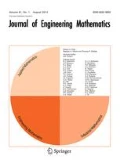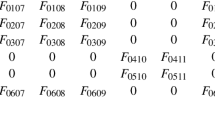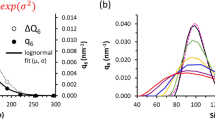Abstract
An effective-medium theory for the electrical conductivity of Ohmic dispersions taking explicit account of particle shape and spatial distribution independently is available from the work of Ponte Castañeda and Willis [J Mech Phys Solids 43:1919–1951, 1996]. When both shape and distribution take particular “ellipsoidal” forms, the theory provides analytically explicit estimates. The purpose of the present work is to evaluate the predictive capabilities of these estimates when dispersions exhibit dissimilar particle shape and distribution. To this end, comparisons are made with numerical bounds for coated ellipsoid assemblages computed via the finite element method. It is found that estimates and bounds exhibit good agreement for the entire range of volume fractions, aspect ratios, and conductivity contrasts considered, including those limiting values corresponding to an isotropic distribution of circular cracks. The fact that the explicit estimates lie systematically within the numerical bounds hints at their possible realizability beyond the class of isotropic dispersions.





Similar content being viewed by others
References
Banisi S, Finch JA, Laplante Ar (1993) Electrical conductivity of dispersions: a review. Minerals Eng 6:369–385
Ponte Castañeda P, Willis JR (1996) The effect of spatial distribution on the effective behavior of composite materials and cracked media. J Mech Phys Solids 43:1919–1951
Giordano S (2017) Nonlinear effective properties of heterogeneous materials with ellipsoidal microstructure. Mech Mater 105:16–28
Willis JR (1977) Bounds and self-consistent estimates for the overall properties of anisotropic composites. J Mech Phys Solids 25:185–202
Hashin Z (1962) The elastic moduli of heterogeneous materials. J Appl Mech 29:143–150
Milton GW (2002) The theory of composites. Cambridge University Press, Cambridge
Milton GW (2019) Private communication
Barrett KE, Talbot DRS (1996) Bounds for the effective properties of a nonlinear two-phase composite dielectric. In: Markov KZ (ed) Proceedings on 8th international symposium, continuum models and discrete systems. World Scientific, Singapore, pp 92–99
Pastor Y, Ponte Castañeda P (2002) Yield criteria for porous media in plane strain: second-order estimates versus numerical results. Compt Rend Mec 330:741–747
Ochoa I (2018) Non-linear electrical conductivity in biphasic materials. Masters Thesis, Universidad de Buenos Aires
Acknowledgements
The work of M.I.I. was funded by the Agencia Nacional de Promoción Científica y Tecnológica through Grant PICT-2014-1988 and by the Universidad Nacional de La Plata through Grant I-2017-225.
Author information
Authors and Affiliations
Corresponding author
Additional information
Publisher's Note
Springer Nature remains neutral with regard to jurisdictional claims in published maps and institutional affiliations.
Appendix: The tensor \(\mathbf{P}\) for an isotropic tensor \({\varvec{\sigma }}^{(1)}\) and an axisymmetric tensor \(\mathbf{Z}\)
Appendix: The tensor \(\mathbf{P}\) for an isotropic tensor \({\varvec{\sigma }}^{(1)}\) and an axisymmetric tensor \(\mathbf{Z}\)
Let \({\varvec{\sigma }}^{(1)} = \sigma ^{(1)} \mathbf{I}\) and \(\mathbf{Z}= a_\parallel \mathbf{e} \otimes \mathbf{e} + a_\perp (\mathbf{I}- \mathbf{e} \otimes \mathbf{e})\), where \(\mathbf{I}\) is the identity tensor and \(\mathbf{e}\) is the unit vector indicating the direction of axial symmetry of \(\mathbf{Z}\). In view of the isotropy of \({\varvec{\sigma }}^{(1)}\), the corresponding tensor \(\mathbf{P}\), as given by (2), inherits the axial symmetry of \(\mathbf{Z}\). Thus, we can write \(\sigma ^{(1)}\mathbf{P}= P_\parallel \mathbf{e} \otimes \mathbf{e} + P_\perp (\mathbf{I}- \mathbf{e} \otimes \mathbf{e})\), where
Expressions (4) follow from these.
Rights and permissions
About this article
Cite this article
Ochoa, I., Idiart, M.I. Explicit estimates versus numerical bounds for the electrical conductivity of dispersions with dissimilar particle shape and distribution. J Eng Math 123, 165–171 (2020). https://doi.org/10.1007/s10665-020-10060-9
Received:
Accepted:
Published:
Issue Date:
DOI: https://doi.org/10.1007/s10665-020-10060-9




